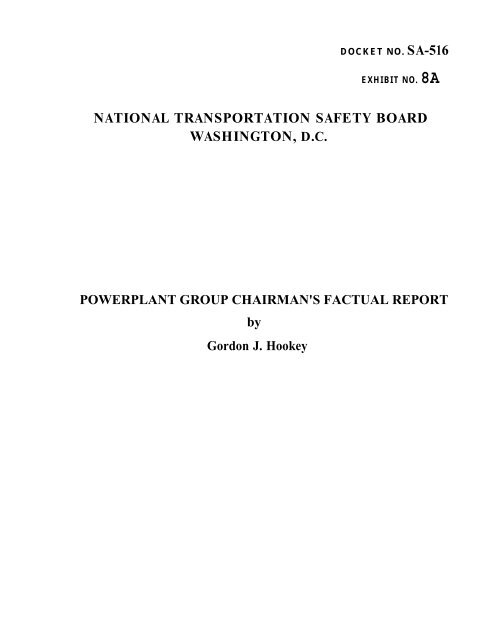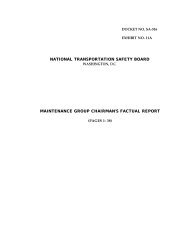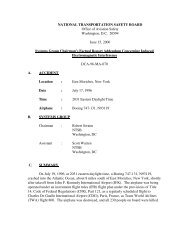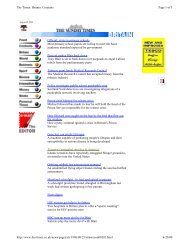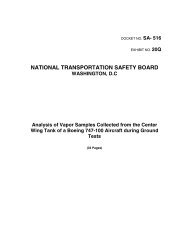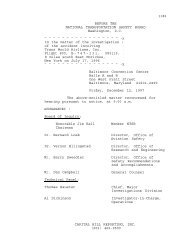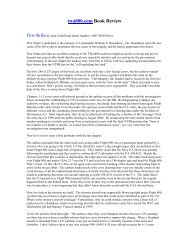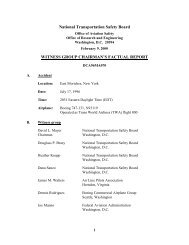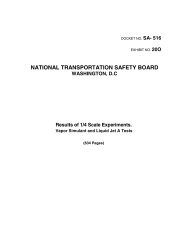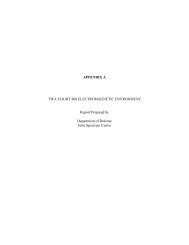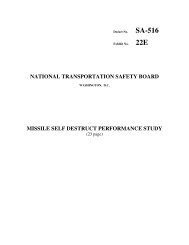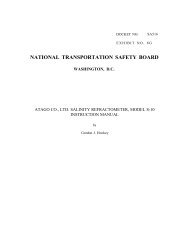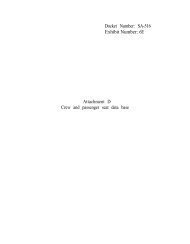Exhibit No. 8A - Group Chairman Factual Report - TWA Flight 800 ...
Exhibit No. 8A - Group Chairman Factual Report - TWA Flight 800 ...
Exhibit No. 8A - Group Chairman Factual Report - TWA Flight 800 ...
- No tags were found...
You also want an ePaper? Increase the reach of your titles
YUMPU automatically turns print PDFs into web optimized ePapers that Google loves.
DOCKET NO. SA-516EXHIBIT NO. <strong>8A</strong>NATIONAL TRANSPORTATION SAFETY BOARDWASHINGTON, D.C.POWERPLANT GROUP CHAIRMAN'S FACTUAL REPORTbyGordon J. Hookey
NATIONAL TRANSPORTATION SAFETY BOARDOFFICE OF AVIATION SAFETYWASHINGTON, D.C. 20594February 25, 1997POWERPLANTS GROUP CHAIRMAN'S FACTUAL REPORT OF INVESTIGATIONA. ACCIDENTNTSB ID <strong>No</strong>.: DCA96MA070Location:East Moriches, New YorkDate: July 17, 1996Time:2031 eastern daylight time (EDT)Aircraft: Boeing 747-131, N93119, Trans World Airlines, <strong>Flight</strong> <strong>800</strong>B. POWERPLANTS GROUPGordon J. Hookey<strong>Group</strong> <strong>Chairman</strong>Jerome FrechetteJames WildeyMetallurgistThomas TodinoNational Transportation Safety BoardWashington, D.C.National Transportation Safety BoardWashington, D.C.National Transportation Safety BoardWashington, D.C.Federal Aviation AdministrationGarden City, New YorkG. Michael Collins Federal Aviation AdministrationRenton, WashingtonVan J. WintersRobert K. SlocombeCharles J. HaleRobert J. GrierRichard ParkerBoeingSeattle, WashingtonTrans World AirlinesKansas City, MissouriInternational Association of MachinistsJamaica, New YorkInternational Association of MachinistsSt. Louis, MissouriPratt & WhitneyEast Hartford, Connecticut
2James D. SpeerAir Line Pilots AssociationSt. Louis, MissouriC. SUMMARYOn July 17, 1996, at about 2031 eastern daylight time (EDT), a Boeing 747-131 airplane,N93119, operated by Trans World Airlines (<strong>TWA</strong>) as flight <strong>No</strong>. <strong>800</strong>, crashed into the AtlanticOcean, south of East Moriches, New York. The airplane experienced an in-flight explosion andbreak-up before it crashed into the ocean. The airplane was operating on an instrument flightrules (IFR) flight plan under the provisions of Title 14 Code of Federal Regulations (CFR) Part121 as a regularly scheduled flight from John F. Kennedy International Airport, Jamaica, NewYork (JFK) to Charles de Gaulle Airport, Paris, France. The 230 passengers and crew memberson board were fatally injured.The four engines were recovered from the Atlantic Ocean by the U.S. Navy’s USS Graspand Grapple under the direction of the U.S. Navy Supervisor of Salvage. After the engines wererecovered, they were transported to the former Grumman facility at Calverton, New York, fordisassembly. The disassembly of the engines commenced on August 12, 1996, in the presence ofthe Powerplants <strong>Group</strong>. The disassembly was completed on August 16, 1996.The disassembly of the engines consisted of removing the cowling, external components,fan, and low pressure compressor (LPC) to expose the high pressure compressor (HPC), diffuser,combustor, high pressure turbine (HPT), low pressure turbine (LPT), and turbine exhaust cases.Engine <strong>No</strong>. 3 was disassembled further to remove and partially disassemble the HPC. Thedisassembly of the engines did not show any indications that any of the engines had sustained anyuncontainments, case ruptures, fires, or penetrations. The inlet cowlings, fan blades, and LPCblades for all four engines were examined with an ultraviolet light, or black light, and none of thesurfaces examined fluoresced.Fuel samples that were collected from the four engines during the disassembly, in additionto a fuel sample that was drained from a <strong>TWA</strong> 747 that had arrived from Athens, Greece, wereanalyzed by Saybolt, a petrochemical laboratory in Kenilworth, New Jersey, on October 17, 1996.The analysis showed that the fuel from the engines of flight <strong>800</strong> had a flash point of 123 o F andthe fuel from the flight from Athens had a flash point of 114 o F. Both of the flash pointsconformed to the specifications for jet fuel manufactured in the United States and Europe,respectively.A fuel sample that had been collected from the JFK fuel supply system immediatelyfollowing the crash of flight <strong>800</strong>, and some of the fuel sample that had been drained from the<strong>TWA</strong> 747, which had arrived from Athens, were analyzed by Saybolt, on December 17, 1996, forelectrical conductivity. The electrical conductivity readings for the fuel samples were 90picosiemens per meter (pS/m) for the fuel from Athens and 0 pS/m for the fuel from JFK.D. DETAILS OF INVESTIGATION1.0 Engine Information1.1 Engine HistoryThe Boeing 747-131 airplane, N93119, was equipped with four Pratt &Whitney (P&W) JT9D-7AH engines. The engines were installed on the airplane as follows:
<strong>TWA</strong> SERIAL TOTAL TOTAL DATEPOSITION NO. NUMBER TIME CYCLES INSTALLED1 4293 662209 47,989 9,684 12/31/952 4151 662593 80,884 14,609 12/6/953 4133 662426 80,336 14,632 6/18/964 4142 662463 77,061 14,016 5/11/96<strong>TWA</strong> provided a copy of the list of serial numbers of the modules on theinstalled engines. Those serial numbers were used to identify each of the four engines as eachwas recovered. A copy of the list of module serial numbers that <strong>TWA</strong> provided is attached.For more detailed information regarding the engines' history, refer to theMaintenance Records <strong>Group</strong> Chairperson's <strong>Factual</strong> <strong>Report</strong> of Investigation.1.2 Engine Description3The P&W JT9D-7AH engine is a dual spool, axial flow high bypassturbofan that has a 1-stage fan, 3-stage low pressure compressor (LPC), 11-stage high pressurecompressor (HPC), annular combustor with 20 fuel nozzles, 2-stage high pressure turbine (HPT),and a 4-stage low pressure turbine (LPT). The fan and LPC, and the HPC are interconnected withdrive shafts to the LPT and the HPT, respectively. The JT9D-7AH turbofan engine has a normaltakeoff thrust rating of 46,150 pounds, flat-rated to 80 o F. 12.0 Engine <strong>No</strong>. 1 Serial Number (SN) 6622092.1 PylonThe pylon was still attached to the engine. The recovered piece of pylonwas the structure between the forward and aft engine mounts. The pylon did not have anyindications of any fire damage, sooting, or penetrations. Examination of the ends of the wires onthe pylon by the on-site National Transportation Safety Board metallurgist did not disclose anyindications of arcing.2.2 NacelleTwo pieces of the inlet cowling, each about 90 to 100° in circumference,were recovered, separated from the engine at the fan case forward flange, "A" flange. 2 The fulllength of the inlet cowling was crushed on the bottom, centered around the 5:30 to 6:00 location. 3The outer diameter (OD) lip of the inlet cowl was crushed on the bottom, but retained its shapefor the remainder of the circumference. The cowling structure and the inner diameter (ID) andOD skin on the fractured ends of the cowling were peeled back towards the top of the cowling.1 Flat-rated to a specific temperature indicates the engine will be capable of reaching the rated thrust level up to thespecified temperature.2 Gas turbine engine industry convention is to identify the engine case flanges alphabetically from front to rear. Acopy of a cross section of the JT9D engine with the flange locations identified is attached.3 All locations on the engine, or direction, as referenced to the clock are as viewed from the rear, looking forward, unlessotherwise specified.
The painted OD surface of the cowling and the acoustic liner of the inlet duct did not have anyindications of sooting. The engine cowling did not have any indications of any penetrations ordamage from a fractured fan blade.A portion of the outboard fan cowl, which was tagged has having beenrecovered floating on the surface, had fire damage on the interior and exterior surfaces about 2-feet in diameter on each side.Three of the four thrust reverser actuators were recovered. All had thejackscrew drives at the forward end of the jackscrews, which is the stowed position.2.3 Fan4The fan case was intact, although it was twisted and ovalized from thebottom. There were no indications of any containment challenges or penetrations through the fancase. The fan rub strip was almost completely missing from 3:30 to 8:00, with only intermittentsections of the forward edge and one section of the rear of the of rub strip remaining. The fan rubstrip was rubbed down to the fan case wall, with metal to metal contact with the fan blades, from4:30 to 7:00. There were no apparent new rub marks on the rub strip from about 9:00 to 10:00.The rub strip had a series of impact marks of the fan blade tips spaced at about 6 1/2-inchintervals from about 4:00 to 8:00 and 11:00 to 1:00. The fan blade tip stagger is about 6 1/2inches. The front and rear edges of the fan blade rub marks on the rub strip were axially locatedaft of "A" flange as follows (all dimensions are in inches):LOCATION FRONT REAR12:00 1 3/16 5 7/163:00 1 3/16 5 3/46:00 1 3/16 NA9:00 1 3/16 5 3/16NA:<strong>No</strong>t available. The rear dimension at the 6:00 location was not obtainablebecause the rubstrip material was missing.shaft.The fan hub was intact and still attached to the low pressure turbine (LPT)Of the 46 fan blades installed in the fan rotor, 31 complete airfoils wererecovered, either intact or fractured. There were 15 fan blade roots recovered, some of whichhad sections of airfoil. The broken airfoils were fractured at various lengths from just above theblade root platform to just outboard of the mid span shrouds. The fan blades that were orientedtowards the bottom of the engine were fractured transversely across the airfoil just above theblade root platforms. The other blades in the clockwise and counter-clockwise directions fromthe bottom of the engine were full length and bent over towards and away from the direction ofengine rotation, respectively. The fracture surfaces on the fractured fan blades were notremarkable. The leading edges (LEs) and trailing edges (TEs) of the fan blades were undamagedexcept for some randomly located impact damage. The fan blade tips were blackened at the veryend and most of the blades had a gold tint at the convex LE tip under the blackened area andalong the full chord length on the concave side from contact with the fan case rub strip.
The fan exit case struts were all fractured transversely about 3 to 4 inchesfrom the intermediate case, except for the strut at the 1:30 location, which was fracturedtransversely about 17 inches outboard of the intermediate case. The thrust yoke was intact andattached to the rear mount, but was separated from the left and right forward attachments.2.4 Low Pressure Compressor5The LPC case was crushed from the bottom and did not have anyindications of any uncontainments or penetrations. The second, third, and fourth stagecompressor disks were intact. Almost all of the compressor airfoils were full length, with about a150 o arc of blades that were bent over away from the direction of rotation. The blades did nothave any damage to the leading or trailing edges.2.5 High Pressure CompressorThe HPC cases were crushed inward from about 3:30 to 8:00 and wereseparated at the HPC case split line flange, "J" flange. The cases did not have any indications ofpenetrations or uncontainments. The rear HPC case had a 4 ½-inch long axial fracture from therear flange at about 7:30 that "teed" to a circumferential fracture that ran from the 4:00 to 8:00location.The HPC inlet guide vanes (IGVs) were in the closed position, except for asector of nine adjacent vanes at the 7:00 location that were rotated to nearly perpendicular to theengine centerline. The IGVs were lightly sooted on the inner half of the airfoil on the convex andconcave surfaces.The fifth stage compressor blades, which were visible through the HPCIGVs, had the blade tips curled into the direction of rotation and had nicks on the LE near thetips. The eighth stage compressor blades, which were visible through the ninth stage compressorbleed port at 9:00, were bent over away from the direction of engine rotation adjacent to the bladeroot platform.2.6 Diffuser/CombustorThe diffuser and combustor cases were crushed inward from about 3:00 to7:00. The diffuser case was fractured circumferentially from about the 3:00 to 9:00 location, justforward of the fuel nozzle mount pads. The diffuser case rear skirt and combustor case werefractured axially at 4:00. The upper right portions of the cases, from about 12:30 to the fracturedends, were bent up almost vertically against the pylon. The lower portions of the cases werepushed inward against the combustor liner. The fracture surfaces on the diffuser and combustorcases were examined by the on-site Safety Board metallurgist and determined to be rapid tensileoverload type fractures with no indications of fatigue. There was no apparent indication of heatdistress on the inner surfaces of the cases. The center of the boss plug at the 6:00 location wasmissing, with the fracture surface oriented towards the OD. The cases did not have anypenetrations.The combustor liner was crushed flat against the inner combustor case onthe bottom and lower right side of the engine. The liner did not have any metallization orindication of any thermal distress.
6The fuel nozzles and external fuel manifolds did not have indication of firedamage. The backs of the fuel nozzles did not have any metallization.2.7 High Pressure TurbineThe high pressure turbine (HPT) case was intact and did not have anyuncontainments or penetrations.The first and second stage turbine blades were fractured at about mid spanand bent over away from the direction of engine rotation adjacent to the blade root platforms. Thefirst and second stage turbine vanes had nicks and dents to the leading and trailing edges and thevanes at the bottom of the case were crushed. The HPT airfoils did not have any metallization.2.8 Low Pressure TurbineThe LPT shaft was intact. The shaft was bent about 29-inches aft of thespacer face reference just aft of a 3 1/4-inch long (axial) x 7-inch wide (circumferential) rub fromthe sixth stage compressor hub bore ID. The shaft also had two localized rubs at 24 ½- to 26 ½-and 77- to 79 ¾-inches aft of the spacer face. The shaft had two 360 o circumferential rubs at 13½- to 15-inches aft of the spacer face and on the front OD face of the bell flare at the rear of theshaft.The LPT case was fractured circumferentially 360 o around between theplane of the second stage turbine rotor and the third stage turbine vane front lugs. The forwardportion of the LPT case remained bolted to the HPT case and the aft portion was bolted to theturbine exhaust case (TEC). The front and rear portions of the LPT case did not have anyindications of uncontainments or penetrations.The third, fourth, and sixth stage turbine disks and the fifth stage turbinehub were intact. The fourth stage turbine disk rim was bent rearward in line with the section ofthe LPT case that was crushed. The fifth stage hub and sixth stage turbine disk, which wererecovered several weeks after the engine, also had the rims bent rearward for a similar arc lengthas the fourth stage turbine disk rim.All of the third stage turbine blades remained in the disk. About half of theblades, in a continuous arc with the exception of a cluster of four blades and one single blade,were fractured transversely at various lengths that ranged from adjacent to the blade root platformto about mid span. The intact third stage blades were all full length and had very little damage tothe leading and trailing edges. Of the 110 fourth stage turbine blades, 81 remained in the disk.There was a 180 o arc of fourth stage blades that were full length, except for a continuous sector of13 blades in the center that were fractured at varying lengths from adjacent to the blade rootplatform to about mid span. The blades that were full length had very little damage to the tipshrouds and to the leading and trailing edges. The other blades that were broken were fracturedtransversely across the airfoil adjacent to the blade root platform. About half of the blades in thefifth stage turbine hub and sixth stage turbine disk remained in the blade slots and all werefractured transversely across the airfoil just above the blade root platforms. There was nometallization on any of the LPT airfoils.
72.9 ExhaustThe TEC was fractured axially at the 10:00 location and the fractured endswere opened outward away from the engine center line. There was an axial fracture at the 4:00location and the case wall pieces remained attached to the case by the mount rails. The TEC wascrushed up against the turbine exhaust inner duct, which was also crushed. The case rails on thebottom of the case were separated from the walls and pushed rearward. The two bottom turbineexhaust struts were folded over. The other struts remained attached to the inner duct, although allwere bent and partially torn from the inner standup welds and completely separated from the outercase wall. The turbine exhaust case and duct walls and turbine exhaust struts did not have anyindications of any uncontainments or penetrations.The <strong>No</strong>. 4 bearing housing was still in the turbine exhaust duct (inner case).The bearing compartment cover was in place and did not have any penetrations. The <strong>No</strong>. 4bearing cage was intact, although all of the bearing rollers were missing from the cage pockets.One roller was found loose in the <strong>No</strong>. 4 bearing housing sump. The roller and outer race did notshow any indication of rotational distress.3.0 Engine <strong>No</strong>. 2 SN 6625933.1 PylonThe pylon was separated from the engine, although it was recovered andreturned to the Grumman facility with the engine. The right side of the pylon had crushingdamage with the skin pushed inward around the internal structure. The skin on the lower left sideof the pylon was bent outward. The pylon did not have any fire damage, sooting, or penetrations.The ends of the wires in the pylon were examined by the on-site Safety Board metallurgist andthere was no indication of arcing noted.the pylon.The engine mounts had separated from the engine and remained attached to3.2 NacelleTwo large pieces of the inlet cowling, each about 90 to 100 o incircumference, were recovered. These pieces had separated from the engine at the fan case frontflange, "A" flange. The full length of the right side of the inlet cowling, centered around 3:30,was crushed. The OD lip of the inlet cowl was crushed on the right side, but retained its shape forthe remainder of the circumference. The ID and OD skin on the fractured ends of the cowlingwere peeled back towards the left side of the cowling. The painted OD surface of the cowling andthe acoustic liner of the inlet duct did not have any indications of sooting. The recovered portionsof the inlet cowling did not have any indications of any penetrations or damage from a fracturedfan blade.All four of the thrust reverser actuators were recovered. All had thejackscrew drives at the forward end of the jackscrews, which is the stowed position.3.3 FanThe fan case was fractured axially at about the 6:30 location. The case wascrushed from the right side from about the 12:00 to 6:00 location. Sections of the fan exit case,
8thrust reverser ring, forward engine mount, and front section of the pylon remained attached to thefan case. The fan case did not have any indications of any containment challenge or penetrations.The fan rub strip material was almost completely missing from about 12:30 to about 6:30.Within this arc, there were indications of metal-to-metal contact between the blade tip and the fancase ID wall at 3:30 and 6:30. Also, within the 12:30 to 6:30 arc, the rub strip was rubbed downto below the bottom of the axial skewed groove (ASG) pockets, though not down to bare metal,between 4:00 and 6:00. There was a separate rub, which was out of the fan plane of rotation,through the rub strip down to the case wall from 9:00 to 10:00, and the rub intersected the fancase rub strip forward retaining lip, causing a burr on the lip from 10:00 to 11:30. The front andrear edges of the fan blade rub marks on the rub strip were axially located aft of "A" flange asfollows (all dimensions are in inches):LOCATION FRONT REAR12:00 0 5 1/23:00 NA NA6:00 1 11/16 NA9:00 7/8 6 1/8NA:<strong>No</strong>t Available. The front and rear dimension at 3:00 and the reardimension at the 6:00 location was not obtainable because the rubstripmaterial was missing.The fan hub was intact and still attached to the LPT shaft.Of the 46 fan blades, 43 were recovered. The fan blades that were orientedtowards the bottom of the engine were fractured transversely across the airfoil adjacent to theblade root platform. The fracture surfaces of the fan blades that were fractured were notremarkable. The other blades in the clockwise and counterclockwise directions from the bottomof the engine were full length and were bent over towards and away from the direction of enginerotation, respectively. The blades located on the left side of the engine were relatively straightand full length. The fan rotor had a few randomly located blades that had impact damage to theleading and trailing edges. All of the fan blades were rubbed on the convex side tip from the LE,aft about 1- to 2 ½- inches and from the tip inboard about 3 /8-inch. The fan case rub strip frontretaining lip was approximately 3 /8-inches high. The concave side of the airfoil tip had a gold tintfrom the tip inboard about 5 /8-inch for the full chord length of the airfoil from contact with therub strip.The fan exit case had all but two of the struts broken off about 3-inchesoutboard of the case at the standup weld. The struts that remained on the case were at the bottomof the engine were full length and were buckled on the left side at the inner end.3.4 Low Pressure CompressorThe LPC was crushed on the right side. There were no indications of anyuncontainments or penetrations. The second, third, and fourth stage compressor disks wereintact. The second, third, and fourth stage compressor blades were all in place and full length.The blades on the right side of the engine were bent over both towards and away from thedirection of rotation. The other LPC blades were not bent.
3.5 High Pressure Compressor9The HPC cases were intact and did not have any indications of anyuncontainments or penetrations. The HPC case split line flange, "J" flange was open on the rightside. The HPC cases were crushed from 2:00 to 5:00.The HPC IGVs were rotated so the airfoils were almost perpendicular tothe centerline of the engine with the convex side facing forward. The inner half of the airfoilswere lightly coated with soot.The thrust yoke was fractured from the right side of the intermediate case,but remained attached at the left side and also to the rear mount.3.6 Diffuser/CombustorThe diffuser and combustor cases were crushed inward from the 2:00 to5:00 location. The diffuser case skirt had a 17-inch long circumferential split that was 4 1/2-inches forward of the diffuser case rear flange at the 8:00 location. The cases did not have anyindications of ruptures, penetrations, or thermal distress. The center of the combustor case bossplug at the 6:00 location was missing with the fracture surface oriented towards the OD of theengine.The fuel nozzles and external manifolds did not have any indications of firedamage. The backs of the fuel nozzles did not have any metallization.3.7 High Pressure TurbineThe HPT case was intact and did not have any indications ofuncontainments or penetrations.The first and second stage turbine blades, which were visible through theseparation between the combustor case and the HPT case, had the tips bent away from thedirection of rotation. The visible HPT blades and vanes did not have any metallization on theairfoil surfaces.3.8 Low Pressure TurbineThe LPT case was fractured circumferentially in the plane of the fourthstage turbine rotor. The rear portion of the LPT case remained bolted to the TEC. The LPT casedid not have any indications of any uncontainments or penetrations.The fourth and sixth stage turbine disks and the fifth stage turbine hub wereintact, but the rims were bent rearward about 20 to 30 o over an arc of about 45 o that was centeredaround the 3:30 location.The fourth stage turbine blades had a 90 o arc of blades that were fracturedtransversely across the airfoil at varying lengths. The remaining fourth stage turbine blades wereall full length, although they had nicks and dents on the leading and trailing edges. About 50percent of the fifth stage turbine blades and about 40 percent of the sixth stage turbine bladeswere intact with complete airfoils. The fractured fifth stage blades had all of the roots remainingin the disk and were fractured from just above the blade root platform to about 4 1/2-inches above
10the blade root platforms. The sixth stage turbine rotor had arcs of 17 and 31 blade roots with theairfoils fractured adjacent to the blade root platforms that were separated by a continuous sector of11 blade slots that had only the rivets remaining in the slots. The rivets showed the blades hadbeen pushed out from front to rear. The LPT airfoils did not have any metallization.3.9 ExhaustThe TEC was crushed against the turbine exhaust duct from about 2:00 to6:00. The turbine exhaust struts on the right side were folded over and telescoped into the strut.The four struts from about the 6:00 to 9:00 location were fractured transversely, alternately fromthe inner and outer standup welds.The <strong>No</strong>. 4 bearing cage was intact, but six of the rollers were missing fromthe pockets. Two of the rollers were found in the <strong>No</strong>. 4 bearing sump. The rollers did not showany apparent rotational distress. The <strong>No</strong>. 4 bearing housing rear cover did not have anypenetrations.The exhaust duct was crushed almost flat from the right side from about12:30 to 6:00. There was about a 2-foot long section of the turbine exhaust plug that was crushedflat in the turbine exhaust duct.4.0 Engine <strong>No</strong>. 3 SN 6624264.1 PylonThe pylon remained attached to the engine. The recovered pylon structureextended from just aft of the fan struts to in-line with the turbine exhaust case mount rails on theleft side of the pylon and two rib bays further aft on the right side and bottom. The nose sectionof the pylon was missing and the fractured upper skin on the pylon was bent upwards andtowards the rear. The bottom of the pylon over the engine mount was buckled and the adjacentskin on the right side was buckled inward. The pylon did not have any indication of fire damage,sooting, or penetrations. The ends of the wires in the pylon were examined by the on-site SafetyBoard metallurgist and there was no indication of arcing noted.The pylon was received with two Halon fire bottles, with the squibsattached, still installed. After the bottles were removed from the pylon, the squibs were removed,and the bottles and squibs were turned over to a bomb technician for storage in the on-siteexplosive ordinance (EOD) bunker.4.2 NacelleThe inlet was separated from the engine and broken into several pieces. Apiece of the inlet support structure had a 3-foot section of the inlet lip that was crushed fromimpact on the front and bottom. The white-painted areas on the OD of the inlet were sooted. Theinlet case did not have any indications of any penetrations or damage from a fractured fan blade.One of the four thrust reverser actuators was recovered. The jackscrewdrive was at the forward end of the jackscrew, which is the stowed position.
114.3 FanThe fan case was intact and had very little deformation. The fan blade rubstrip was in place and had a relatively uniform rub around the entire circumference. The rub stripwas rubbed down to where the bottom of the ASG was visible for most of the circumference. Thedeepest rub into the rub strip was down flush to the bottom of the ASG from 4:30 to 7:00. Thefan case did not have any indications of any containment challenges or penetrations. The frontand rear edges of the fan blade rub marks on the rub strip were axially located aft of "A" flange asfollows (all dimensions are in inches):LOCATION FRONT REAR12:00 1 5 7/163:00 1 5/16 5 1/26:00 1 5/16 5 11/169:00 1 1/4 5 1/2The fan hub had a 360 o circumferential fracture in the web just outboard ofthe hub and the rim was completely separated from the hub. The rim section was recovered withthe engine and the hub remained attached to the LPT shaft. The fracture surfaces on the hub andrim sections were not smeared. The rim section, which was a complete ring, had two fracturesinto the web: a circumferential fracture about 14 1/4-inches long and an "S"-shaped fracture thatwas about 9-inches long. A comparison of the fracture surfaces on the hub and the rim showedthat some of the hub pieces were not recovered.Of the 46 fan blades in the fan rotor, 21 blades with complete or partialairfoils and 6 root sections were recovered. All of the fan blades had sooting on the convex airfoilsurfaces. Most of the full length airfoils were bent rearward and the tips outboard of the outermidspan shroud were bent forward slightly. About half of the fan blades had impact damage tothe leading and trailing edges. Almost all of the impact damage to the airfoils could be matched tocontact with the midspan shroud on an adjacent blade. One full length blade had four soft bodyimpacts along the leading edge and a partial airfoil had a soft body impact, which had somestreaking extending rearward. The fracture surfaces on the fractured fan blades were notremarkable. The fan blades had a very slight gold tint on the concave surface adjacent to the tipsfrom rubbing the rub strip.The fan exit case was intact. All of the fan exit struts were fracturedtransversely from the case about 2 1/2-inches outboard from the inner ring.4.4 Low Pressure CompressorThe LPC was compressed axially so that the LPC hub was forced aft of thestub shaft. The LPC did not have any indications of any uncontainments or penetrations.The second and third stage compressor disks were intact. The fourth stagecompressor disk was fractured with the rim separated from the conical section. About half of thefourth stage compressor disk rim was missing.The second stage compressor rotor was displaced rearward so that thesecond stage compressor blades were intermeshed with the second stage stator vanes. All of thesecond stage blades were pushed out of the slots, except for a group of 11 blades that had the tips
12curled towards the direction of engine rotation. All of the third stage compressor blades remainedin the disk. Most of the third stage blades were bent over away from the direction of rotation,except for a continuous sector of 17 blades that were bent over towards the direction of enginerotation. The fourth stage compressor blades, which were in the piece of rim section thatremained attached to the disk, were bent over towards the direction of engine rotation.4.5 High Pressure CompressorThe HPC cases were crushed from the bottom. The HPC cases wereseparated at the split line flange, "J" flange. The HPC case had a 360 o circumferential fracture inline with the seventh stage compressor stator vane unison ring. The HPC cases did not have anyindications of any uncontainments or penetrations. The thrust yoke was still attached to the frontright and rear attachments, but was separated from the front left attachment.The HPC IGVs were rotated so that the airfoils were almost perpendicularto the engine centerline with the convex side facing forward. The IGVs had sooting on the innerhalf of the airfoil surfaces. The HPC blades were bent over away from the direction of enginerotation.4.6 Diffuser/CombustorThe diffuser and combustor cases were intact. The cases did not have anyindications of any uncontainments, penetrations, or fire damage.The external fuel nozzle manifolds did not have any indication of firedamage. The backs of the fuel nozzles did not have any metallization.4.7 High Pressure TurbineThe HPT case was intact and did not have any indications of anyuncontainments or penetrations.4.8 Low Pressure TurbineThe LPT case was intact, but was crushed on the bottom and lower rightside. The LPT case did not have any indications of any uncontainments or penetrations.The fifth stage turbine hub and sixth stage turbine disk were intact. A 180 oarc of the fifth stage turbine blades, at the top of the engine, were full length. The fifth stageblades at the bottom of the engine were bent in both the clockwise and counterclockwisedirections and fractured at various lengths. The sixth stage turbine blades had two sectors of 15and 20 blades at 3:00 and 9:00, respectively, that were full length. The only other sixth stageturbine blades that remained in the disk were a group of eight blades, which were located on thelower right side of the engine, that were fractured adjacent to the blade root platform. The LPTairfoils did not have any metallization.4.9 ExhaustThe TEC was separated from the LPT case, but was returned with theengine. The only piece of the TEC that remained attached to the LPT case was a section of the
13front flange and duct forward of the mount rail at the 9:00 to 1:00 location. The TEC did not haveany indications of any penetrations.The turbine exhaust duct was separated from the case, but was alsoreturned with the engine. The <strong>No</strong>. 4 bearing was intact with all of the rollers in place. The rollersdid not have any indication of rotational distress.5.0 Engine <strong>No</strong>. 4 SN 6624635.1 PylonThe pylon had separated from the engine, although the engine mountsremained attached to the pylon. The pylon was crushed on the right side and was buckled inwardin the center of the left side. The front of the pylon was crushed aft about 2 feet. The pylon didnot have any indications of fire damage, sooting, or penetrations. The ends of the wires in thepylon were examined by the on-site Safety Board metallurgist and there was no indication ofarcing noted.The pylon was received with two Halon fire bottles still installed, one ofwhich still had a squib attached. After the Halon bottles were removed from the pylon and thesquib was removed from the one bottle, the bottles and squib were turned over to a bombtechnician for storage in the on-site EOD bunker.5.2 NacelleTwo pieces of the inlet cowling, an 8-foot long section of the outboardcowl and a 4-foot long section of the inboard cowl, were recovered. The upper left portion of theinlet cowling had soot on the white-painted surfaces. The inlet lip was crushed flat from front toback.Three of the four thrust reverser actuators were recovered. All had thejackscrew drives at the forward end of the jackscrews, which is the stowed position.5.3 FanThe fan case was intact, although it was twisted and warped. Almost all ofthe fan blade rub strip was still in place and appeared to have fresh rubs around the entirecircumference. The area of the deepest uniform rub extends from 3:00 to 6:00, which wascoincident with the center of impact to the engine. The rub strip was rubbed down to the bottomof the ASG pockets from 10:30 to 3:00, but had localized areas, spaced at 6 ½-inch intervals, thatwere rubbed down below the ASG pockets. (The fan blade tip stagger is 6 ½ inches.) The rubstrip was rubbed down to the bare metal of the fan case from 1:00 to 1:30. The front and rearedges of the fan blade rub marks on the rub strip were axially located aft of "A" flange as follows(all dimensions are in inches):LOCATION FRONT REAR12:00 1 5/16 5 1/43:00 1 5/16 5 1/86:00 1 3/8 5 1/29:00 1 3/8 5 3/8
14The fan hub was intact and was still attached to the LPT shaft.Of the 46 fan blades, 41 were recovered, either full length airfoils or bladeroots and airfoil sections. All of the airfoils had impact damage to the leading and trailing edges.There were 13 fan blades were fractured transversely across the airfoil just above the blade rootplatform. The fracture surfaces of the fractured blades were not remarkable. The full lengthairfoils were bent rearward. The fan blades did not have any sooting on the airfoil surfaces, butthe tips were blackened.The fan exit case struts were all fractured transversely just outboard of theinner ring standup welds.5.4 Low Pressure CompressorThe LPC was crushed inward from the right and axially from the front.The third and fourth stage compressor disks were intact. The second stage compressor disk hadradial fracture at 2:00, but the disk was otherwise complete and intact.The LPC airfoils were bent over in both the clockwise andcounterclockwise directions on the right side of the compressor. Almost all of the airfoils on theleft side of the compressor were full length and straight, although a few were bent slightly in bothdirections at the tips. The LPC did not have any indications of any uncontainments orpenetrations.5.5 High Pressure CompressorThe HPC case was buckled at the 3:00 location and was crushed slightly ataround the 4:30 location. The case was fractured circumferentially in line with the seventh stagestator vane unison ring from 6:00 to 9:00. The case had a 9-inch long circumferential fracture,centered around 3:00, between the HPC case front and split line flanges, "H" and "J" flangesrespectively. The HPC cases did not have any indications of any uncontainments or penetrations.The thrust yoke was attached to the three attachment points.The HPC IGVs were rotated so the airfoils were perpendicular to theengine centerline with the convex side facing forward. The IGV airfoils did not have any sooting.5.6 Diffuser/CombustorThe diffuser and combustor cases were crushed from about 1:00 to 4:00.The diffuser case skirt was fractured circumferentially just aft of the fuel nozzle mount pads fromabout 2:00 to 8:00. The combustor case was separated from the diffuser case at "L" flange, fromabout 1:00 to 2:00, where the cases were crushed. The combustor case was separated from theHPT case at "M" flange, from 2:00 to 4:00. The center of the combustor case boss at 6:00 wasmissing with the fracture surfaces oriented towards the OD. The diffuser and combustor cases didnot have any indications of any ruptures, penetrations, or fire damage.The fuel nozzles and external manifolds did not have any indications of firedamage. There was no metallization on the backs of the fuel nozzles.
155.7 High Pressure TurbineThe HPT case was intact and did not have any indications of anyuncontainments or penetrations.The first stage turbine blades were fractured above the blade root platformand the ends were bent over away from the direction of engine rotation. The HPT airfoils did nothave any metallization.5.8 Low Pressure TurbineThe LPT case was intact, except for a 9-inch long section from the rearflange from 1:00 to 6:00 that was missing. The LPT case did not have any indications of anyuncontainments or penetrations.The fourth stage turbine disk and the fifth stage turbine hub were intact, butboth had a 90 o arc of the rims that were bent rearward. The sixth stage turbine disk was intactexcept for a 90 o arc of the rim that was fractured through the air seal bolt holes and was missing.The fifth stage turbine blades, from about 6:00 to 1:00, were full length.The remaining fifth stage blades were either fractured transversely across the airfoil just above theblade root platform or were missing from the blade slots in the disk. The sixth stage turbine rotorhad two sectors of four and nine blades located at 9:00 and 10:00, respectively, that were fulllength. All of the other sixth stage blades were missing from the disk except for 13 randomlylocated blades that were fractured at various lengths up to 2-inches from the blade root platform.The LPT airfoils did not have any metallization.5.9 ExhaustThe TEC was fractured axially at the 11:00 location and was bent andtwisted. The TEC did not have any indications of any penetrations.The turbine exhaust duct had been separated from the case and wasreturned with the engine. The duct was intact and did not have any indications of anypenetrations.The <strong>No</strong>. 4 bearing housing was intact. The <strong>No</strong>. 4 bearing cage was intact,but eight of the rollers were missing from the pockets and were not recovered. The remainingrollers did not have any rotational distress.6.0 Turbine Exhaust PlugsThe turbine exhaust plugs from all four engines were recovered. One plug wasessentially undamaged, although it had a circumferential dent on one side. The remaining threeplugs were broken into circumferential ring segments that were all crushed flat. <strong>No</strong>ne of theturbine exhaust plugs had any indications of any penetrations.7.0 Auxiliary Power UnitThe auxiliary power unit (APU) was recovered intact. The cases on the left side ofthe APU were crushed inward. The APU's cases did not have any indications of fire damage,
uncontainments, or penetrations. The compressor blades and turbine blades visible in the inletand exhaust, respectively, did not appear to have any damage.The APU exhaust pipe was recovered full length. The exhaust pipe was crushedon the bottom and was buckled inward at 9:00. The pipe did not have any indications ofpenetrations.8.0 Fuel Analysis - Density, Specific Gravity, American Petroleum Gravity, FlashPoint, and Manual Distillation, October 17, 19968.1 Fuel Collection16During the disassembly of the four engines, fuel was found in the fuelmanifolds just upstream of the fuel nozzles. Clear glass specimen jars were obtained from theFederal Bureau of Investigation's (FBI) on-site laboratory to collect the fuel. As the "B" nuts onthe manifolds were loosened and the manifold lines separated, any fluid (fuel or water) that was inthose lines was drained into the jars. The jars used to store the fuel from engines <strong>No</strong>. 1, 2, and 3were about the size of a large baby food jar. The fuel from the <strong>No</strong>. 4 engine was collected in twobottles that were about the size of a small pharmacy pill bottle. The smaller jars were used tocollect the fuel from the <strong>No</strong>. 4 engine so as to not delay the disassembly of the engine because theFBI laboratory had temporarily run out of the larger jars. Immediately after the fuel was collectedand the cap was secured tightly on the top of the jar, the Powerplants <strong>Group</strong> <strong>Chairman</strong> markedeach jar, using a felt tip pen, to identify what engine the fuel sample came from, the date, and theninitialed it. For the larger jars used for the fuel from engines <strong>No</strong>. 1, 2, and 3, the markings wereplaced on the cap. For the smaller containers used for the fuel from engine <strong>No</strong>. 4, the markingswere placed on the sides of the bottles. The caps on each of the jars were then secured withplastic package tape. The jars of fuel were kept in the hangar used for the disassembly of theengines. At the completion of the activities of the Powerplants <strong>Group</strong>, the jars of fuel were turnedover to a bomb technician, New York City Police Department Detective Joseph S. Cordaro, forstorage in the on-site EOD bunker.The amount of fuel collected from each engine varied. The fuel collectedfrom engines <strong>No</strong>. 1 and 2 was very little, estimated to be approximately 1 milliliters (ml) and 2ml, respectively. The fuel collected from engine <strong>No</strong>. 3 was estimated to be a total of about 24 ml,in two jars. The fuel collected from engines <strong>No</strong>. 1, 2, and 3, was also contaminated with varyingamounts of a cloudy liquid that would pool up in the bottom of the fuel in each jar. The cloudyfluid in each jar had visible particles in suspension. The fuel collected from the <strong>No</strong>. 4 engine wasestimated to be about 16 ml, and appeared to be clean with no readily visible particles or otherfluids.In addition, an estimated 50 ml of fuel was decanted from a 1-pint metalcontainer, which was in the NTSB command post at the Grumman facility, into a large glassspecimen jar that had been obtained from the on-site FBI laboratory. The can was labeled that thefuel had been drained from the center body fuel tank of a <strong>TWA</strong> Boeing 747, airplane <strong>No</strong>. 17134,that had just arrived at JFK from Athens, Greece (ATH), as <strong>TWA</strong> flight <strong>No</strong>. 881. <strong>TWA</strong> haddrained the fuel from the airplane's center body fuel tank around October 1, 1996, and provided itto the Safety Board, at the request of Dr. Merritt Birky, Fire and Explosion <strong>Group</strong> <strong>Chairman</strong>, whohad given approval to decant the 50 ml sample.
178.2 Fuel AnalysisThe Powerplants <strong>Group</strong> <strong>Chairman</strong> contacted Saybolt Incorporated, apetrochemical laboratory, in Kenilworth, New Jersey, to analyze the fuel collected. Saybolt wasselected after the Powerplants <strong>Group</strong> <strong>Chairman</strong> had contacted a number of airport fixed basedoperators (FBOs) and aviation fuel delivery companies in the New York City area and requestedthe name of the laboratory they use for fuel analysis. All of the companies that had beencontacted indicated they used Saybolt as their fuel analysis laboratory.On October 9, 1996, Mr. William Koeck, Saybolt District Manager, andDr. Nabil Mohtadi, Saybolt Kenilworth Laboratory Manager, accompanied the Powerplants<strong>Group</strong> <strong>Chairman</strong>, to the Grumman facility to pick up the fuel samples. An inspection of the jarsof fuel after they were returned from the EOD bunker showed that they were all still tightly sealedand the packing tape was in place, which did not appear to have been disturbed. After thesamples were logged out of the facility by an FBI evidence response team member, Mr. Koeckand Dr. Mohtadi hand carried the fuel samples to Saybolt's laboratory in Kenilworth, New Jersey.They stated that upon arrival in Kenilworth, they would start an inventory list, and then store thesamples in a sealed box until they were to be analyzed.On October 17, 1996, the fuel samples from the engine of <strong>TWA</strong> flight <strong>800</strong>and from the center body fuel tank of the <strong>TWA</strong> 747 from Athens, flight <strong>No</strong>. 881, were analyzedby Saybolt, in the presence of the Powerplants <strong>Group</strong> <strong>Chairman</strong>. All of the investigation partycoordinators had been advised that the fuel analysis was going to be conducted at Saybolt,Kenilworth, on this date, however none of the parties elected to participate in the analysis. Mr.Koeck and Dr. Mohtadi stated that when they had returned to the Saybolt laboratory inKenilworth from Calverton on October 9, 1996, they listed each of the samples on an inventorysheet and then sealed the fuel samples in a box. An examination of the box, sealing wire, andseals, showed that all were intact. The numbers on the three seals, <strong>No</strong>. 372178, 372333, and372089, matched the numbers listed on the inventory sheet. (A copy of the inventory log sheet isattached.) After the sealing wire and tape around the box was removed and the box opened, thejars containing the fuel samples were removed and examined. The numbers and informationlisted on the inventory tags and written on each of the bottles matched the numbers andinformation listed on the inventory sheet. The jars and plastic package tape were intact and eachappeared to be in the same condition as when they were last observed at the Grumman facility.With the limited amount of fuel that was available for analysis and uponreview of the recommendations that had been solicited from Boeing and P&W as to what fuelattributes should be analyzed, it was decided to test the fuel samples from flights <strong>800</strong> and 881 fordensity, specific gravity, American Petroleum Institute gravity (APIG), flash point, and manualdistillation. (Copies of Boeing's and P&W's recommendations for the fuel analysis are attached.)Because of the limited amount of fuel that was extracted from the engines of flight <strong>800</strong>, it wasnecessary to combine the samples of fuel to accomplish the flash point and manual distillationtests. In addition, the cloudy liquid that was in the bottom of the fuel samples from flight <strong>800</strong>,was believed to be salt water, and was tested for salinity. All of the laboratory work on the fuelsamples was done by Mr. William Moran, a senior laboratory technician for Saybolt, under thesupervision of Dr. Mohtadi.The liquid in the bottom of the fuel samples from <strong>TWA</strong> flight <strong>800</strong>'s <strong>No</strong>. 1,2, and 3 engines, was believed to be salt water, and was tested for salinity using an AtagoCompany, Ltd. salinity refractometer, Model S-10. The fuel sample from engine <strong>No</strong>. 4 did nothave any other visible liquids mixed in and so was not tested. The refractometer measures the
18salinity of water by placing a small amount of water on the prism on one end of the meter andthen covering the prism and drop of water with a daylight plate, which was a square glass slide.The meter is held up towards a light source and by looking through the eyepiece at the oppositeend from the prism, a blue bar and a scaled reticle is visible. The top of the blue bar on the reticleis the percentage of salt in the water, or salinity, in grams of salt per 100 grams of water. Themeter was checked for calibration by placing a drop of distilled water on the prism, covering itwith the daylight plate, and then observing that the blue bar was on the zero point on the reticle.(A copy of the instruction manual for the salinity refractometer is attached.) A small amount ofthe liquid was drawn from the bottom of the fuel samples from engines <strong>No</strong>. 1, 2, and 3, using apipette and a drop was placed on the prism that was then covered with the daylight plate and themeter was held up to the light source to determine the salinity. The pipette, prism, and daylightplate were cleaned between each test of the water samples using distilled water. The results of thesalinity tests were as follows:Lab <strong>No</strong>. Engine Salinity1096364 1 3.5%1096365 2 3.5%1096366 3 3.7%1096356 3 3.2% ** The initial salinity test on the sample of liquid from the second jar of fuelfrom engine <strong>No</strong>. 3, lab <strong>No</strong>. 1096367, was off-scale. After the glass tray ofthe prism and the daylight plate were cleaned with distilled water, the secondtest resulted in the salinity reading of 3.2%.The density, specific gravity, and APIG of the fuel samples were measuredusing a Paar density meter, model <strong>No</strong>. DMA-48. The testing for density and specific gravityusing a digital density tester is outlined in the American Society of Testing and Materials (ASTM)Standard D4052. (A copy of ASTM Standard D4052 is attached.) Before the start of the test, thetest chamber of the unit was cleaned with acetone and blown dry with low pressure shop air. Totest the fuel for density, specific gravity, and APIG, a small amount of fuel is decanted from thetop of the sample using a sterile syringe. The tip of the syringe is inserted into a port on the rightside of the test unit and some fuel is pumped into a glass chamber that is viewable through a smallwindow in the front of the unit. A light in the unit is turned on and the fuel is pumped in anddrawn out slightly to ensure there are no air bubbles in the sample to be tested. When it is certainthere are no air bubbles in the sample, the light is turned off and the test is started. The unitautomatically cools the sample down to 15.5 o C (the light must be off or it will warm the fuel andresult in false test readings) and then measures the density, specific gravity, and APIG. After thetest, the fuel sample is withdrawn from the test chamber in the unit and returned to its originalcontainer. The test chamber was cleaned after each sample was tested with the acetone andblowing the chamber dry with the low pressure shop air. Each sample was decanted from its jarusing a fresh sterile syringe. The calibration of the unit is checked daily using toluene by aprocess known as control charting. 4 The control charting check that was accomplished just priorto the unit being used for the fuel samples from <strong>TWA</strong>'s flight <strong>No</strong>. <strong>800</strong> and 881 resulted in adensity reading of 0.8709 for the toluene test fluid. The test was accomplished on the fuel from<strong>TWA</strong> <strong>800</strong> <strong>No</strong>. 3 and 4 engines, and the fuel from Athens. The results of the tests were asfollows:4 Control charting checks the density of a known test fluid to ensure the readings stay within a required range. If thereadings fall out of the required range, the unit must be adjusted.
SpecificLog <strong>No</strong>. Engine Density Gravity APIG1096367 3 0.8118 0.8126 42.631096369 4 0.8117 0.8125 42.661096370 4 0.8116 0.8124 42.681096368 ATH 0.7979 0.7987 45.6619The fuel samples were tested to determine the flash point using a FisherTag Closed Cup Tester ASTM D-56. The closed cup flash point test is outlined in ASTMstandard D-56. (A copy of ASTM standard D-56 is attached.) Because of the limited amount offuel that was recovered from the four engines, it was necessary to combine all of the samples fromthe engines to have enough to accomplish the flash point test. The combined fuel sample wasidentified as a composite, Saybolt Log <strong>No</strong>. 1096630. The flash point test is accomplished byplacing about 50 ml of the fuel into a clean metal cup. The cup is then set in a holder so that thebottom of the cup is setting in a bath of water at room temperature. A cover is placed over thefuel sample. The cover has a small window, which is normally closed, and a very small gas jetthat is ignited. The gas jet can be rotated down to the window, which is rigged to open as the gasjet is rotated towards the window. The water bath is heated electrically to warm the fuel toproduce vapors. A rheostat on the base unit controls the amount of heat input to the water tocontrol the temperature increase of the fuel to 2°F per minute. The temperature of the fuel andwater bath were measured with ASTM 9F thermometers, SN 30024 and A06043, respectively,both of which had stickers indicating they were due for calibration in April 1997. Mr. Moranused a stop watch throughout the test to ensure the temperature increase was at the required rateand had to adjust the rheostat several times to decrease or increase the rate of temperature rise tomeet the 2 o F per minute requirement. As the fuel is warmed and produces vapors, the lit gas jet isrotated down to the window at every 1°F increase of temperature of the fuel. The flash point of afuel sample is the temperature of the fuel when the lit gas jet ignites the vapors in the cup. Thecomposite fuel sample from the engines of <strong>TWA</strong> flight <strong>800</strong> was tested first and found to have aflash point of 123 o F. The fuel from the center body fuel tank of the <strong>TWA</strong> 747 from Athens, flight<strong>No</strong>. 881, was then tested and found to have a flash point of 114 o F. The barometric pressureduring the flash point tests was 763 mm Hg.The distillation was the last test accomplished to the fuel samples. Theprocedure for the distillation test for jet fuel is outlined in ASTM standard D86. (A copy ofASTM standard D86 is attached.) The ASTM standard specifies that 100 ml is required toaccomplish the distillation test. Since the combined fuel from the four engines of flight <strong>800</strong> andthe fuel remaining from the Athens flight after the other tests had been completed amounted toabout 50 ml each, the test was accomplished using those quantities and the residual amounts wereprorated. It should be noted that the sample of fuel from the engines of flight <strong>800</strong> that was usedfor the distillation test was the same composite sample that had been used for the flash point test.Dr. Mohtadi pointed out that the flash point test might have burned off some of the lighter ends ofthe fuel and altered the initial boiling point (IBP) part of the test. The distillation test isaccomplished by placing the sample in a distillation flask. A stopper with a thermometer, whichhad a sticker indicating the calibration was due in April 1997, was put on to the top of the flask.The vent from the top of the flask was plugged into a condenser, which was a coiled tube througha room temperature water bath that drained into a graduated cylinder. The fuel in the flask washeated electrically to boiling. As the vapors from the boiling fuel rose, they flowed out throughthe vent and into the condenser. The temperature at which the first drop of liquid falls from thecondenser into the graduated cylinder is recorded as the IBP. As the liquid continues to flow from
20the condenser into the graduated cylinder and reaches the required measurement levels, thetemperature is recorded. When the fuel in the distillation flask has been almost completely boiledaway, the temperature in the flask will stop rising and then drop. The maximum temperature risebefore it began to drop is the end point (EP). When the residue in the distillation flask is cool, itis measured in a clean graduated cylinder. The sum of the distilled fuel in the graduated cylinderand the residue is subtracted from the starting quantity of fuel to determine the loss. The resultsof the distillation test were as follows:BarometricBarometricCorrectedCorrectedFlt <strong>800</strong> Temperature ATH TemperatureIBP 322 o F 321.8 o F 306 o F 305.8 o F2.5 ml 348 347.8 322 321.85.0 360 359.8 339 338.87.5 372 371.8 350 349.810.0 380 379.8 361 360.815.0 390 389.8 372 371.820.0 406 405.8 384 383.825.0 418 417.8 394 393.830.0 432 431.8 406 405.835.0 446 445.8 420 421.840.0 466 465.8 434 433.842.5 476 475.8 446 445.845.0 492 491.8 454 453.847.5 xxx xxx.x 472 471.8EP 504 503.8 482 481.8Recovered-Actual 49 ml (50 ml) 48ml (49ml)(starting amount)Recovered(percentage) 98.0 98.0Residue(percentage) 1.6 1.4Loss(percentage) 0.4 0.6The barometric pressure during the distillation tests was 762 mm Hg.All of the fuel and residue remaining from the tests was saved in jars,packed in boxes, and returned to the Grumman facility at Calverton, New York, by NTSB staff.A copy of Saybolt's laboratory report on the fuel samples is attached.9.0 Fuel Analysis - Electrical Conductivity, December 17, 1996On December 13, 1996, two samples of jet fuel were hand carried, by the Powerplants<strong>Group</strong> <strong>Chairman</strong>, from the Grumman facility at Calverton, New York, to Saybolt, in Kenilworth,New Jersey, to be tested for electrical conductivity. Saybolt was selected to do the fuel electricalconductivity tests because they had accomplished the previous testing of fuel from the engines of<strong>TWA</strong> flight <strong>800</strong> and the fuel from <strong>TWA</strong> flight 881 from Athens. On December 17, 1996, in thepresence of the Powerplants <strong>Group</strong> <strong>Chairman</strong>, both of the fuel samples were tested for electricalconductivity in accordance with ASTM Standard D-2624-95, “Standard Test Methods forElectrical Conductivity of Aviation and Distillate Fuels.” (A copy of the ASTM SpecificationD2624 is attached.) The tests were accomplished by Mr. Roy Pike, a Saybolt senior laboratorytechnician, under the direction of Dr. Nabil Mohtadi, Saybolt Kenilworth Laboratory Manager.
21The party coordinators had been advised at the progress meeting on December 12, 1996, that thisfuel testing was going to be accomplished, however none of the parties elected to participate.The electrical conductivity of fuel is the ability of the fuel to dissipate a static charge. Theunit of measure is picosiemens per meter (pS/m). A siemen, which is also called a conductivityunit (cu), is the reciprocal of an ohm, the unit of electrical resistance. A siemen is also known asa mho. (1pS/m = 1 x 10 -12 Ω -1 m -1 = 1 cu = 1picomho/m)The test for the electrical conductivity of fuel was accomplished in the following manner.A stainless steel cup was cleaned by rinsing it out with acetone, then washing it out with soap andwater, rinsing it with distilled water, rinsing it again with acetone, and then drying out the insideof the cup with shop air. The inside of the stainless steel cup was examined and was found tohave no residual moisture or odors. Fuel was poured from the respective containers into thestainless steel cup to a depth of about 4 to 5 inches. The ASTM specification stated the testshould be accomplished at room temperature. Using an ASTM 12F thermometer serial number(SN) 1N4304, which had the calibration last checked on April 16, 1996, the temperature of thetwo fuel samples just prior to each test was 70°F. The electrical conductivity of the fuel wasmeasured with an Emcee Electronics, Inc. Model 1152 Digital Conductivity MeterSN 14912, which had a sticker indicating that it was last calibrated on May 6, 1996, and that thenext calibration was due on May 6, 1997. (A copy of the meter certification for meter SN 14912is attached.) The meter consists of two parts: the meter box, which has a liquid crystal display(LCD) indicator and two buttons that are marked ‘M’ and ‘C’, and a probe that is inserted into aplug in the bottom of the meter. The calibration of the meter can be checked by pressing thebutton marked ‘C’ and it must indicate 10 times the number marked on the probe. The probe wasannotated with the number 41 and the LCD indicated 410 when the ‘C’ button was pressed. Theprobe was rinsed off with a small amount of fuel from each sample to rinse away any potentialresidue. The probe was dipped into each fuel sample three times and on the third immersion, itwas held steady in the sample and the ‘M’ button was pressed. The number that appeared on theLCD within three seconds after the ‘M’ button was pressed was the electrical conductivity readingfor that fuel sample. The stainless steel cup was cleaned and the probe was rinsed with fuelbetween each of the tests. (A copy of the Emcee Electronics Model 1152 Digital ConductivityMeter operation manual is attached.) Separate from the ASTM test for electrical conductivity, thefuel in the stainless steel cup was poured into a graduated cylinder to measure how much fuel hadbeen poured from the containers for each of the tests.The results the electrical conductivity tests on the fuel samples were as follows:Athens fuelKennedy fuelSource <strong>TWA</strong> 881 Cart 856Sampling date October 1, 1996 July 17, 1996Quantity of fuel tested 685 ml 645 mlTemperature 70°F 70°FElectrical conductivity reading 90 pS/m 0 pS/mA copy of Saybolt’s test results is attached.
22Although the specification for jet fuel has no requirement for fuel conductivity, the ASTMrecommendation for conductivity in JetA fuel is 50-450 pS/m. 5 (A copy of the ASTMspecification is attached.)Gordon J. HookeyPowerplants <strong>Group</strong> <strong>Chairman</strong>5 Jet Fuel Specifications, (Exxon, 1990), p. 6
23ATTACHMENTS1. <strong>TWA</strong> list of modules and engine serial numbers installed on Boeing 747-131, N93119.2. Cross section of JT9D engine identifying engine case flanges.3. Boeing letter to NTSB, dated September 26, 1996, with recommendations for fuel tests toaccomplished on fuel from <strong>TWA</strong> flight <strong>800</strong>.4. P&W letter to NTSB, dated February 16, 1990, regarding analysis of fuel from Aviancaflight 502, that was for comparison of what testing to accomplish on fuel from <strong>TWA</strong>flight <strong>800</strong>.5. Saybolt Inc. Sample Receipt/Retain/Disposal Log inventory sheet for fuel samples from<strong>TWA</strong> flight <strong>800</strong> and from <strong>TWA</strong> flight 881 from Athens.6. Atago Co., Ltd. Salinity Refractometer, Model S-10, Instruction Manual7. ASTM Standard D4052: "Standard Test Method for Density and Relative Density ofLiquids by Digital Density Meter."8. ASTM Standard D56: "Standard Test Method of Flash Point by Tag Closed Tester."9. ASTM Standard D86: "Standard Test Method for Distillation of Petroleum Products."10. Copy of Saybolt's laboratory report on the fuel samples tested on October 17, 1996.11. ASTM Standard D-2624-95, “Standard Test Methods for Electrical Conductivity ofAviation and Distillate Fuels.”12. Certificate of calibration for digital conductivity meter SN 14912.13. Emcee Electronics Model 1152 Digital Conductivity Meter Operation Manual14. Copy of Saybolt's laboratory report on the fuel samples tested on December 17, 1996.15. ASTM Jet Fuel Specification Recommendation.


